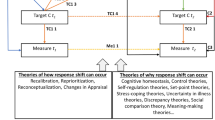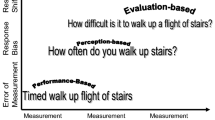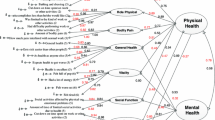Abstract
Aims:
When individuals experience changes in their health states, they may alter their internal standards, values, or conceptualization of quality of life (QOL). Such ‘response shifts’ can affect or distort QOL outcome measurement, which is of particular concern when evaluating medical or psychosocial interventions. Although clinicians and researchers acknowledge the occurrence of response shifts, little is known about the magnitude and clinical significance of those effects. To fill this gap in knowledge about response shift phenomena, we performed a meta-analysis on published QOL articles on response shift.
Methods:
Extensive literature searches and multiple contacts with researchers yielded a collection of 494 articles for potential reviewing. We retained only published longitudinal studies that measured response shift, resulting in 26, of which 19 reported the requisite data for computing an effect size (ES). We calculated and compared the ESs for each study with regard to potential moderator variables: the QOL domains measured, disease group investigated, sample size, and response shift method used. We rated studies for quality to allow ES weighting.
Results:
When we examined ES absolute values, we found that ES magnitude was small, with the largest ESs detected for fatigue, followed by global QOL, physical role limitation, psychological well-being, and pain (mean |ESweighted| = 0.32, 0.30, 0.24, 0.12, and 0.08, respectively). ESs varied considerably in direction. Aggregating raw ES scores over all studies led to positive and negative values canceling each other out (mean directional ESweighted = 0.17, 0.02, −0.01, 0.06, and 0.02, respectively). We found little evidence of an effect for the moderator variables examined.
Conclusions:
A definitive conclusion on the clinical significance of response shift cannot currently be drawn from existing studies. For a number of reasons, ES estimates were primarily based on then-test results, a method that is not without criticism, such as its susceptibility to recall bias. We recommend a standardized approach for reporting results of future response shift research to advance the field and to facilitate interpretation and comparisons across studies.
Similar content being viewed by others
References
Mosteller F, Colditz GA (1996) Understanding research synthesis (meta-analysis). Annu Rev Public Health. 17:1–23
Cohen J (1992) A power primer. Psychol Bull 112:155–159
Oort FJ, Visser MR, Sprangers MA (2005) An application of structural equation modeling to detect response shifts and true change in quality of life data from cancer patients undergoing invasive surgery. Qual Life Res 14(3):599–609
Cohen J (1988) Statistical Power Analysis for the Behavioral Sciences. Lawrence Erlbaum Associates, Hillsdale, NJ
Sloan JA, Cella D, Hays RD (2005) Clinical significance of patient-reported questionnaire data: another step toward consensus. J Clin Epidemiol 58(12):1217–1219
Sprangers MA, Van Dam FS, Broersen J et al. (1999) Revealing response shift in longitudinal research on fatigue – the use of the thentest approach. Acta Oncol 38(6):709–718
Oort FJ (2005) Using structural equation modeling to detect response shifts and true change. Qual Life Res 14(3):587–598
Visser MR, Oort FJ, Sprangers MA (2005) Methods to detect response shift in quality of life data: A convergent validity study. Qual Life Res 14(3):629–639
Adang EM, Kootstra G, Engel GL, van Hooff JP, Merckelbach HL (1998) Do retrospective and prospective quality of life assessments differ for pancreas–kidney transplant recipients? Transpl Int 11(1):11–15
Ahmed S, Mayo NE, Wood-Dauphinee S, Hanley JA, Cohen SR (2004) Response shift influenced estimates of change in health-related quality of life poststroke. J Clin Epidemiol 57(6):561–570
Ahmed S, Mayo NE, Corbiere M, Wood-Dauphinee S, Hanley J, Cohen R (2005) Change in quality of life of people with stroke over time: True change or response shift?. Qual Life Res 14(3):611–627
Ahmed S, Mayo NE, Wood-Dauphinee S, Hanley JA, Cohen SR (2005) Using the Patient Generated Index to evaluate response shift post-stroke. Qual Life Res 14(10):2247–2257
Bernhard J, Hurny C, Maibach R, Herrmann R, Laffer U (1999) Quality of life as subjective experience: Reframing of perception in patients with colon cancer undergoing radical resection with or without adjuvant chemotherapy. Swiss Group for Clinical Cancer Research (SAKK). Ann Oncol 10(7):775–782
Jansen SJ, Stiggelbout AM, Nooij MA, Noordijk EM, Kievit J (2000) Response shift in quality of life measurement in early-stage breast cancer patients undergoing radiotherapy. Qual Life Res. 9(6):603–615
Joore MA, Potjewijd J, Timmerman AA, Anteunis LJ (2002) Response shift in the measurement of quality of life in hearing impaired adults after hearing aid fitting. Qual Life Res 11(4):299–307
Lepore SJ, Eton DT, Schwartz CE, Sprangers MAG (2000) Response Shifts in Prostate Cancer Patients: An Evaluation of Suppressor and Buffer Models. 8395. Adaptation to Changing Health: Response Shift in Quality-of-Life Research. American Psychological Association, Washington, DC, pp. 37–51
Rapkin BD (2000) Personal goals and response shifts: Understanding the impact of illness and events on the quality of life of people living with AIDS 8400. In: Schwartz CE, Sprangers MAG (eds), Adaptation to Changing Health: Response Shift in Quality-of-Life Research. American Psychological Association, Washington DC, pp. 53–71
Rees J, Clarke MG, Waldron D, O’Boyle C, Ewings P, MacDonagh RP (2005) The measurement of response shift in patients with advanced prostate cancer and their partners. Health Qual Life Outcomes 3(1):21
Schwartz CE, Feinberg RG, Jilinskaia E, Applegate JC (1999) An evaluation of a psychosocial intervention for survivors of childhood cancer: Paradoxical effects of response shift over time. Psychooncology 8(4):344–354
Schwartz CE, Merriman MP, Reed GW, Hammes BJ (2004) Measuring patient treatment preferences in end-of-life care research: Applications for advance care planning interventions and response shift research. J Palliat Med 7(2):233–245
Schwartz CE, Sprangers MAG, Carey A, Reed G (2004) Exploring response shift in longitudinal data. Psychol Health 19(1):51–69
Schwartz CE, Wheeler HB, Hammes B et al. (2002) Early intervention in planning end-of-life care with ambulatory geriatric patients: Results of a pilot trial. Arch Intern Med 162(14):1611–1618
Timmerman AA, Anteunis LJ, Meesters CM (2003) Response-shift bias and parent-reported quality of life in children with otitis media. Arch Otolaryngol Head Neck Surg 129(9):987–991
Visser MR, Smets EM, Sprangers MA, de Haes HJ (2000) How response shift may affect the measurement of change in fatigue. J Pain Symptom Manage 20(1):12–18
Carver CS, Scheier MF (2000) Scaling back goals and recalibration of the affect system are processes in normal adaptive self-regulation: Understanding ‘response shift’ phenomena. Soc Sci Med 50(12):1715–1722
Kahneman D, Tversky A, Moser PK (1990) Prospect Theory: An Analysis of Decision Under Risk. Reality in Action: Contemporary Approaches. Cambridge University Press, New York, NY, pp. 140–170
Norman G (2003) Hi! How are you? Response shift, implicit theories and differing epistemologies. Qual Life Res 12(3):239–249
Obisesan O (2005) The evaluation of upper respiratory tract infection symptoms to show the significance of developing a quality-of-life evaluation instrument for upper respiratory tract infections to assess respiratory disorder-related disability. Am J Ther 12(2):142–150
Schwartz CE, Rapkin BD (2004) Reconsidering the psychometrics of quality of life assessment in light of response shift and appraisal. Health Qual Life Outcomes 2:16
Rapkin BD, Schwartz CE (2004) Toward a theoretical model of quality-of-life appraisal: Implications of findings from studies of response shift. Health Qual Life Outcomes 2:14
Bar-on D, Lazar A, Amir M (2000) Quantitative assessment of response shift in QOL research. Soc Indicators Res 49(1):37–49
Bernhard J, Lowy A, Maibach R, Hurny C (2001) Response shift in the perception of health for utility evaluation. An explorative investigation. Eur J Cancer 37(14):1729–1735
Bernhard J, Lowy A, Mathys N, Herrmann R, Hurny C (2004) Health related quality of life: A changing construct? Qual Life Res 13(7):1187–1197
Cella D, Hahn EA, Dineen K (2002) Meaningful change in cancer-specific quality of life scores: Differences between improvement and worsening. Qual Life Res 11(3):207–221
Hagedoorn M, Sneeuw KC, Aaronson NK (2002) Changes in physical functioning and quality of life in patients with cancer: Response shift and relative evaluation of one’s condition. J Clin Epidemiol 55(2):176–183
Jansen SJ, Stiggelbout AM, Wakker PP, Nooij MA, Noordijk EM, Kievit J (2000) Unstable preferences: A shift in valuation or an effect of the elicitation procedure?. Med Decis Making 20(1):62–71
Postulart D, Adang EM (2000) Response shift and adaptation in chronically ill patients. Med Decis Making 20(2):186–193
Rees J, Waldron D, O’Boyle C, Ewings P, MacDonagh R (2003) Prospective vs. retrospective assessment of lower urinary tract symptoms in patients with advanced prostate cancer: The effect of ‘response shift’. BJU Int 92(7):703–706
Wyrwich KW, Tardino VMS. Understanding global transition assessments. Qual Life Res 2006; (in press)
Author information
Authors and Affiliations
Corresponding author
Appendix A
Appendix A
Rights and permissions
About this article
Cite this article
Schwartz, C.E., Bode, R., Repucci, N. et al. The clinical significance of adaptation to changing health: A meta-analysis of response shift. Qual Life Res 15, 1533–1550 (2006). https://doi.org/10.1007/s11136-006-0025-9
Received:
Accepted:
Published:
Issue Date:
DOI: https://doi.org/10.1007/s11136-006-0025-9




